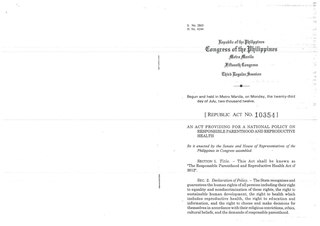
An unsafe abortion is the termination of a pregnancy by people lacking the necessary skills, or in an environment lacking minimal medical standards, or both. An unsafe abortion is a life-threatening procedure. It includes self-induced abortions, abortions in unhygienic conditions, and abortions performed by a medical practitioner who does not provide appropriate post-abortion attention. About 25 million unsafe abortions occur a year, of which most occur in the developing world.
Abortion in El Salvador is illegal. The law formerly permitted an abortion to be performed under some limited circumstances, but in 1998 all exceptions were removed when a new abortion law went into effect.
This is a timeline of reproductive rights legislation, a chronological list of laws and legal decisions affecting human reproductive rights. Reproductive rights are a sub-set of human rights pertaining to issues of reproduction and reproductive health. These rights may include some or all of the following: the right to legal or safe abortion, the right to birth control, the right to access quality reproductive healthcare, and the right to education and access in order to make reproductive choices free from coercion, discrimination, and violence. Reproductive rights may also include the right to receive education about contraception and sexually transmitted infections, and freedom from coerced sterilization, abortion, and contraception, and protection from practices such as female genital mutilation (FGM).
Abortion in India has been legal under various circumstances with the introduction of the Medical Termination of Pregnancy (MTP) Act, 1971. The Medical Termination of Pregnancy Regulations, 2003 were issued under the Act to enable women to access safe and legal abortion services.
Abortion in Venezuela is currently illegal except in some specific cases outlined in the Venezuelan Constitution, and the country has one of Latin America's most restrictive laws.
In Trinidad and Tobago, abortion is illegal save for few exceptions. The respective laws are in place since 1925.

The Dominican Republic is one of 24 countries in the world and one of six in Latin America that has a complete ban on abortion. This complete ban includes situations in which a pregnant person’s life is at risk.

Ipas is an international, non-governmental organization that seeks to increase access to safe abortions and contraception. To this end the organization informs women how to obtain safe and legal abortions and trains relevant partners in Africa, Asia, and Latin America on how to provide and advocate for these.

|belowstyle = background-color:#AAF0D1; |below = Status: In force }} The Responsible Parenthood and Reproductive Health Act of 2012, also known as the Reproductive Health Law or RH Law, and officially designated as Republic Act No. 10354, is a Philippine law that provided universal access to methods on contraception, fertility control, sexual education, and maternal care in the Philippines.
The Irish Family Planning Association (IFPA) is an Irish charity working to enable people to make informed choices about sexuality and reproduction. The organisation promotes the right of all people to sexual and reproductive health information as well as dedicated, confidential and affordable healthcare services.

Abortion-rights movements, also self-styled as pro-choice movements, advocate for the right to have legal access to induced abortion services including elective abortion. They seek to represent and support women who wish to terminate their pregnancy without fear of legal or social backlash. These movements are in direct opposition to anti-abortion movements.

Latin America is home to some of the few countries of the world with a complete ban on abortion and minimal policies on reproductive rights, but it also contains some of the most progressive reproductive rights movements in the world. With roots in indigenous groups, the issues of reproductive rights include abortion, sexual autonomy, reproductive healthcare, and access to contraceptive measures. Modern reproductive rights movements most notably include Marea Verde, which has led to much reproductive legislation reform. Cuba has acted as a trail-blazer towards more liberal reproductive laws for the rest of Latin America, while other countries like El Salvador and Honduras have tightened restrictions on reproductive rights.
Abortion in Uganda is illegal unless performed by a licensed medical doctor in a situation where the woman's life is deemed to be at risk.
Abortion is a controversial topic in Nigeria. Abortion in Nigeria is governed by two laws that differ depending on geographical location. Northern Nigeria is governed by The Penal Code and Southern Nigeria is governed by The Criminal Code. The only legal way to have an abortion in Nigeria is if having the child is going to put the mother's life in danger. However, sex-selective abortion has long had acceptance in Nigeria.
The position of the Philippines on women's rights is relatively developed compared to many other nations. Over the past century, noticeable developments have been made which have led to greater endorsement and protection of these rights. The progression towards gender equality came about through women's movements, increased numbers of women political representatives, increased numbers of educated women, greater specificity on women's issues instituted under legislation, and the focused application of those laws. In recent years, the Filipino government has addressed the rights of women under a multitude of legislative schemes including workplace discrimination, domestic violence, sexual harassment and human trafficking.
In Yemen, abortions are only “permitted to save the life of a pregnant woman”, making it one of the strictest abortion laws in the Middle East and the world. Abortion is not widely accepted in Yemeni society. However, because of the recent conflict in Yemen, rape, honor killings, and unsafe abortions have increased in Yemen. According to a study conducted by Canadian Studies in Population, the number of unsafe and illegal abortions are high in Yemen, which can lead to fatal health risks for women.

Abortion in Kenya is prohibited with the exception of certain circumstances including danger to the life and health of the expectant mother, and rape. Unsafe abortions are a major cause of deaths and health complications for women in Kenya.
Abortion in Rhode Island is legal. On June 19, 2019, the legal right to abortion was codified into Rhode Island law by passage of the Reproductive Privacy Act.
Post-abortion care (PAC) is treatment and counseling for post-abortion women. It includes curative care, such as treating abortion complications, as well as preventative care, such as providing birth control to prevent future unwanted pregnancies. Post-abortion care reduces morbidity and mortality associated with abortion.
In 2005, the Ethiopian Parliament liberalised the abortion law to grant safe abortions to women in specific circumstances.






